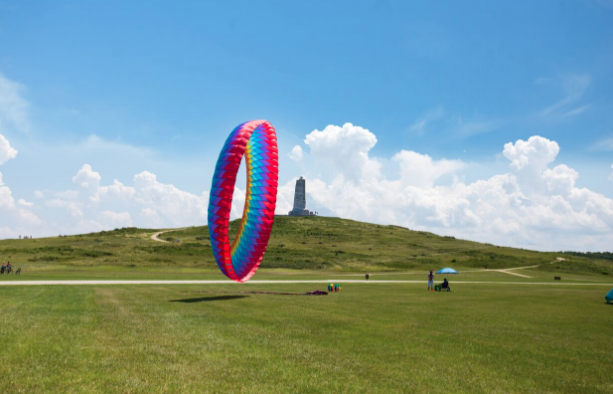When the Wright Brothers first arrived on the Outer Banks in 1900 from Dayton, OH, they initially stayed with Bill Tate, the assistant Post Master for the town (his wife was the Post Master). The house is no longer standing, although there is a marker indicating where it was located on Moor Shore Road. That section of town is often called Kitty Hawk Village and is the oldest settled part of the municipality. Wilbur and Orville Wright later moved their camp to the sand dune and saw a grassy area to the south; this was an area referred to as Kill Devil Hill because of the large dune there. At that time they were still in Kitty Hawk Township, which explains why Kitty Hawk is listed as the location of the first sustained and controlled heavier-than-air powered flight.
The Wright Brothers Memorial in Kill Devil Hills is a beautiful space to explore the historical significance of their first flight on Dec 17, 1903. Explore the museum, climb the winding walkway up the hill to the monument, or climb on the life-size replica statue of their 1903 flyer at the base of the hill.
From the perspective of a local:
Sitting atop Kill Devil Hill, the 60′ granite Wright Brothers Monument is an iconic reminder of the genius of Wilbur and Orville Wright. Inscribed in the granite are the words, “IN COMMEMORATION OF THE CONQUEST OF THE AIR GENIUS ACHIEVED BY DAUNTLESS RESOLUTION AND UNCONQUERABLE FAITH.”
The view from the top of the hill is breathtaking on a clear day, with the ocean, sound, and towns of the Outer Banks visible for miles around.
The tower was the winning entry in a 1928 contest to commemorate 25 years of flight. The art deco motif proposed, by the architects Alfred Easton Poor and Robert Perry, Rodgers is considered a classic in monument design.
The Monument was not completed and dedicated until 1932, but 1928 was an important year for the site of the Wright Brothers’ first flight. To mark the 25th anniversary of the event, a commemorative marker was dedicated with Orville Wright, Amelia Earhart, Charles Lindbergh, and other luminaries on hand.
It was also the year that work began to stabilize Kill Devil Hill. Pushed by the northeast winds off the ocean, the dune had migrated 450′ to the south.
The work of stabilizing the dune was completed in 1931, with construction on the Monument scheduled to begin that year. Before construction could begin, though, a wire fence was placed around the base of the hill to keep, among other things, wild hogs from foraging on the grass.
The Monument was completed in 1932, and in 1933 the property was transferred to the National Park Service. Improvements followed, mostly through funds provided by the Depression Era Works Progress Administration (WPA), including restrooms, paths, and a superintendent’s residence.
It was not until 1960 that the Wright Brothers Memorial took on the final look that it has today.
In December of 1960, the Visitors Center was opened. The building was one of the first major designs of the Philadelphia architecture firm Mitchell/Giurgola, which went on to design a number of architecturally significant buildings.
The building is 9900 square feet, allowing ample room for welcoming visitors and for displays explaining what the Wright Brothers did and how they went about accomplishing something no one else had managed to do.
What becomes apparent when looking at the exhibits on display is that Wilbur and Orville Wright were not dilettantes who lucked into flight.
They were first-rate scientists who observed, recorded, and thought creatively. They were the first people to use a wind tunnel, and it was through their observations of wing design in the wind tunnel that they refined the mathematics of lift on wing surfaces.
That is only one of the exhibits in the Visitors Center.
The centerpiece is the exact replica of the 1903 flyer that is in the rotunda. And it is here that National Park Service interpreters bring the world of the Outer Banks, the Wright Brothers, and the quest for flight alive.
The interpreters are excellent at what they do, and the presentation is fascinating for everyone from six years of age and up.
Outside the Visitors Center, paths lead to replicas of the shacks the brothers used during their experiment between 1900-1901. In 1900 they lived out of a tent.
There are also plaques marking the landing places of the three flights they took that remarkable day in 1903.
The Wright Brothers Memorial is truly a must-see part of the Outer Banks experience. To really experience the site, there is a fair amount of walking to do. The trek to the top of Kill Devil Hill is fairly steep, but the reward is worth the effort.
Including the winding path to the top of the Monument to the Visitors Center is about a half-mile. Other than the path up and down the Monument, it’s all flat, but still, something comfortable for walking will make the visit more enjoyable.
In the summer, sunscreen is a good idea. There is no shade anywhere—much like when the Wright Brothers showed up on Bill Tate’s doorstep in 1903. In the winter…that window the ocean gets awfully cold.
Plan on spending a few hours at the site. It will be time well spent.

